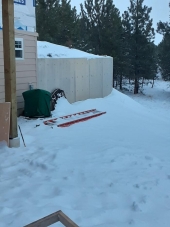Hello Permie People!!

Im new to the forum... well to the posting side... ive been a lurker for years! lol And would like to give everyone a big heartfelt thank you for all of the great info, tips etc you all rock!
OK.. on to my question..... the image above is a sketch up pic of the passive solar greenhouse im building... just got it under roof. IM a glass blower by trade but am a recovering union carpenter ( former life) and have always been interested in alt construction. And this is my attempt to play with some of the useless knowledge that ive accumulated over the years.
Since this is sort of an experimental building (to me) and with the possibitly of selling in the next 10 years I opted to stay in the convention construction material realm.... for resale reasons etc... ( not everyone can see beauty in earthen walls like I do) The building 20x20 sits on a hillside, the foundation on the front portion( greenhouse) is about 5-6 foot deep ( concrete block- sealed), the back 6 foot is more of an enclosed pole building style to house some milking goats (nigerian dwarfs) and a work/ milk bench. The building is insulated with rock wool and the face is exposed cedar with solex covering.
Im planning an aquaponic set up and rocket mass heater ( which im sure ill be back on here asking questions for)

Her eis the question finally.... im sort of stuck at the moment and could use some recommendations/ ideas. Im not sure what to do on the interior greenhouse insulated walls... being im expecting humid air and the mass heater heat etc Some of the solutions ive been thinking about would be... plywood with a white pond liner on the outside ( drawbacks- plywood in a wet area scares me and not sure how it would look), ive seen all sorts of plastic, vinyl wall board solutions but most are pricey and would like to avoid adding more plastics to the mix if possible. Being an artist i had a vision of some sort of concrete art adorning the back wall... not sure if i can do a vertical concrete face over plywood/ drywall etc or perhaps a tuffa? or how it would hold up.
But any ideas would be appreciated .... perhaps this has been addressed elsewhere? or one of you have a magical solution?

Thanks in advance for the time taken to read through this and possibly helping!

I think i got enough info in there let me know if i missed something... ive been doing a time lapse of the building ill share when complete if interested.
thanks again!








